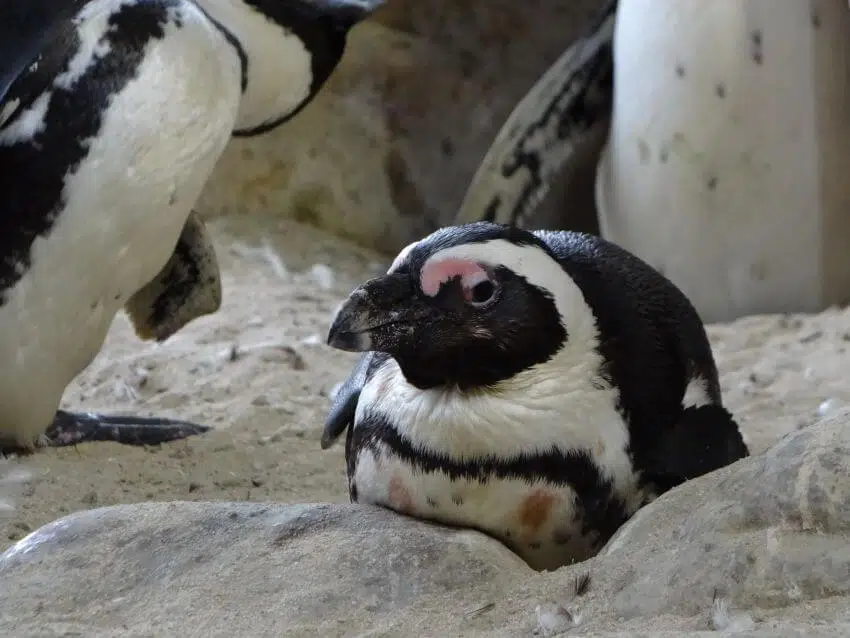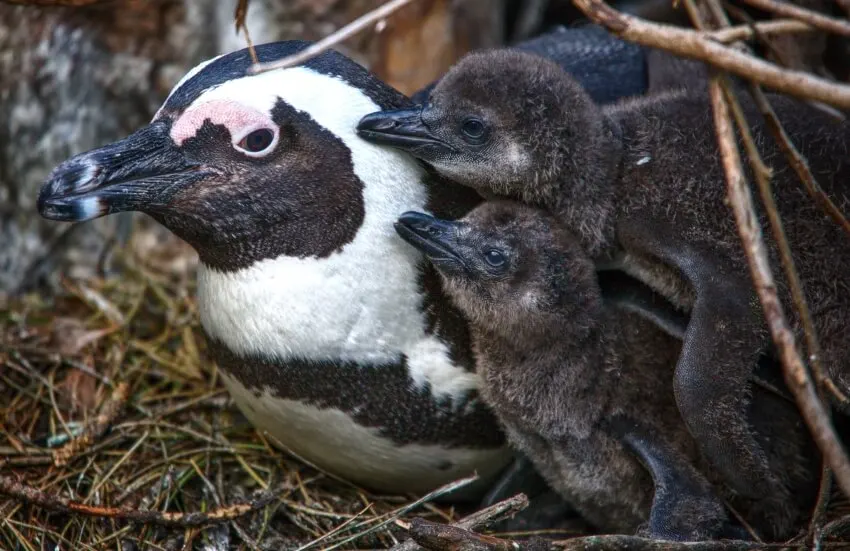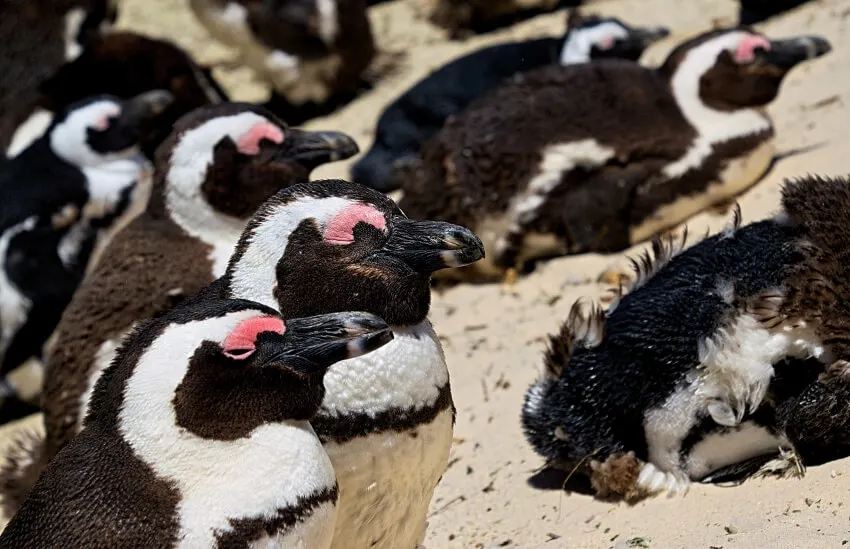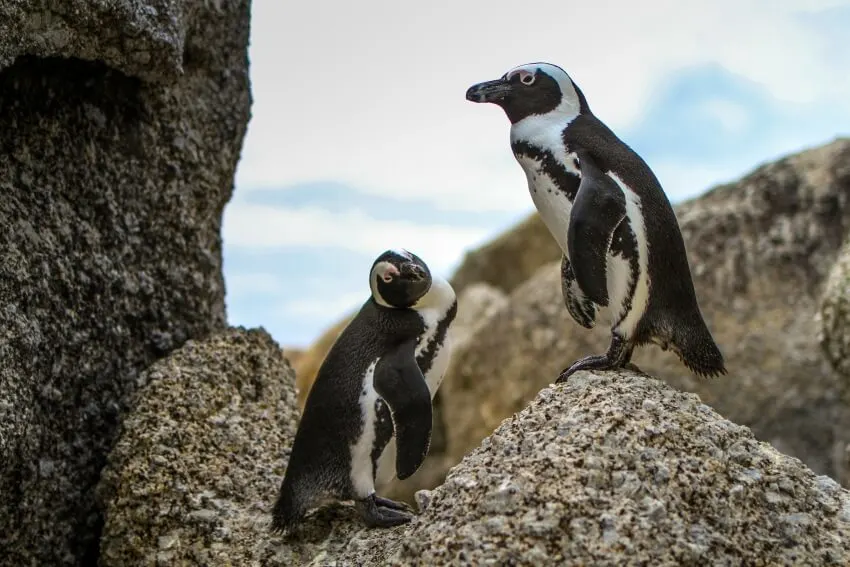African penguins (Spheniscus demersus) are a species of penguin found on the African continent. These penguins are listed as endangered, and there are concerns that they may become extinct soon.
There are several reasons for this, including climate change, pollution, and overfishing. Oil spills also threaten these species.
- Status: Endangered
- Known as: African Penguin, Jackass Penguin, Black-footed Penguin.
- Estimated numbers left in the wild:75,000 to 80,000.
Description

Anatomy and Appearance
Their black and white plumage easily recognizes them. African Penguins have a blackhead, neck, and chest with white patches on their belly, flippers, and tail. They weigh between 2.5 and 5 kg (5.5 and 11 lb) and are about 60 cm (24 in) tall.
African penguins resemble their close penguin relatives. Several other species in the Spheniscus genus, including Pacific ocean and Humboldt penguins, and Magellanic penguins of South America
Like other penguins, they have a compact, upright build, wings specialized for swimming rather than flying, and unique patterns of black and white that are possessed only by a single bird, making individual identification possible. Their braying call gives them the nickname “Jackass penguin.”
Location
African penguins are found along the southern African coast, including the coastal waters out to 40 kilometers (singly, in pairs, or groups of up to 150) and 25 islands, and four onshore breeding sites.
All breeding sites is in Namibia and South Africa. The birds are also found along the shores of nearby African nations, but they do not breed there.
They are colonial birds, though they spend large amounts of time at sea when not breeding. Still, they seldom venture further than 40 kilometers from land.
African Penguin Habitat
These species live in the cold, coastal waters of South Africa and Namibia. They are found on the African continent and the islands near it, mainly in the Benguela Current.
African Penguin Diet and Nutrition
They are fish eaters, predominantly consuming anchovies, pilchards, herring, horse mackerel, and sardines. They will also consume other smaller fish and crustaceans, and squid.
The penguins have a specially adapted beak that is excellent for catching fish. An African penguin can stay underwater for roughly two and a half minutes when diving after prey.
Their diet is relatively low in calcium, so they need to consume bones and scales from their prey to fulfill their calcium requirements. The Penguins typically eat around 450 grams of food per day.
African Penguin Mating Habits

African penguins are monogamous, and a pair will return to the same nesting site year after year during the breeding season if it is not disturbed or destroyed.
They are also the only penguin species that mate in Africa. These penguins naturally dig nesting burrows into thick guano deposits, but if humans have removed these, they will make scrapes in the sand under the shelter of bushes.
These sand nests are inferior to guano nests due to exposure to the elements and ready access to predators, including kelp gulls, but can be used for successful breeding. These penguins will use artificial nests if they are provided.
The male and female take turns incubating the African penguin eggs. A month after they hatch, chicks join a crèche, which allows their parents to resume feeding more normally. These penguins reach sexual maturity at about four years and can live anywhere from 10 to 25 years in the wild.
Captive birds live significantly longer.
The African penguin breeding season is typical during October and November. They typically lay two eggs, but only one chick will normally survive. The penguin chicks will fledge at around 60 days old.
Several breeding colonies of these birds can be found on bird island. One such breeding colony is located on Robben Island, which is located off the coast of Cape Town, South Africa.
Another breeding colony can be found on Dyer Island, which is located off the coast of Gansbaai, South Africa.
Many penguins migrate for one to two years to molt into their adult plumage and return to their birthplace. Those who do not go back home may relocate to other colonies so they can molt and reproduce.
See Related: List of Animals that Mate for Life
African Penguin Role in the Ecosystems
The African penguin is a keystone species in the ecosystems of South Africa. African penguins are carnivores, and their diet consists of mostly fish.
They also eat invertebrates, such as squid, octopus, and crustaceans. African penguins are essential to the ecosystem’s health because they help keep the population of fish in check.
These species are also popular tourist attractions, which bring much-needed revenue to the country. African penguins are endangered due to overfishing, oil spills, and climate change.
The penguin would be a significant loss to the world’s biodiversity. They are an essential part of the food chain on the African coastline, and their extinction would cause a ripple effect throughout the ecosystem.
Additionally, these species are an essential part of the tourism industry in South Africa. Their extinction would lead to a significant loss in revenue and tourism for the country.
See Related: What is Overfishing? Examples & Solutions to Prevent
African Penguin Predators
African penguins have several predators, including leopard seals, cape fur seals, jackass penguins, kelp gulls, and brown skuas. African penguins are also susceptible to oil spills, killing large numbers of this species.
African Penguin vs. Other Penguin Species
African penguins are distinguishable from other penguins by their black and white plumage. They are also the only species of penguin that lives in Africa.
The penguins are further distinguished from other bird species by their smaller and shorter beaks. The penguins weigh 2.5 kg and stand at an average height of 60 cm. They are also the only species of a penguin with a drought-resistant coat of feathers.
African Penguin Facts
Here are the fun facts about African penguins that you need to know.
- These penguins (Spheniscus demersus) can grow up to 5 kg and be 60 centimeters tall.
- Their color is black and white.
- These penguins are also known as jackass penguins because of their noise, which sounds like a donkey’s bray.
- These penguins live on 24 islands off the coast of Southern Africa.
- They are the only penguin found on the African continent.
- The penguin is also the smallest species of penguin in the world.
- These penguins mate for life and can live up to 20 years in the wild.
- The penguin chicks take about 75 days to fledge or grow their adult feathers.
- These penguins eat primarily small fish but will also eat squid and crustaceans.
- They are found along the coast of southern Africa, from Namibia to South Africa.
- These bird species have extended breeding seasons.
- These birds breed on several island groups off the coast of southern Africa, including Dassen Island, Malgas Island, and Robben Island.
See Related: Facts About Conservation
Conservation Status

The African Penguin is listed as vulnerable on the IUCN Red List. The population has decreased by more than 60% in the last three generations. It is estimated that there are currently between 2,000 and 3,000 left in the wild.
Threats
African Penguins are threatened by habitat loss, whaling, fisheries bycatch, and oil slicks. The penguins have also been caught in sweep netting accidents and killed in shark nets set off South African coasts to protect bathers.
Habitat Loss
These species are being threatened by habitat loss. The penguin is a species of penguin found on the southern African coast. These penguins are being threatened by the destruction of their natural and marine habitat, mainly caused by human activity.
Its population has been declining for the past few decades. One of the main reasons for this decline is the destruction of their natural habitat, mainly caused by human activity.
Some of the activities that contribute to this habitat loss include fishing, mining, and oil drilling.
African penguins have been bombarded with man-made threats and problems for over a century and are still seriously menaced by human activity.
Today, drastic shortages of food caused by commercial purse-seine fishing for pelagic fish prey are causing a steady and perhaps irreversible decline of these intriguing birds.
Climate Change
The African penguin is a species of penguin that is found on the African continent. They are listed as endangered on the IUCN Red List, and they are facing several threats, including climate change.
Climate change is already having a significant impact on African penguins, and it is likely to worsen. These birds rely on cold water to survive, and as the ocean warms, their habitat is shrinking.
This means that the penguins are increasingly competing with other marine species for food and space.
Climate change is also causing more extreme weather events, leading to devastating consequences for penguins. For example, powerful storms can damage nests and make it difficult for adults to find food.
These birds are also threatened by oil spills and other forms of pollution. Oil spills can contaminate the water that penguins depend on for food, and they can also cause penguins to lose their feathers, making them more susceptible to cold weather.
Food Shortage
African penguin populations are threatened by food shortages, often caused by climate change and overfishing.
The penguins have been observed in some fishing nets, indicating that they may be struggling to find enough fish to eat, and because of this, penguins are likely to become endangered if these threats continue.
Prey
The African penguin population has declined due to several threats, the most significant of which is predation by marine mammals, such as seals and sharks. Seals are known to predate the penguins of all age groups, and adult African penguins are particularly susceptible to shark predation.
Humans also hunt these birds for their meat and eggs. In some parts of Africa, penguins are considered a delicacy, and they are often killed for food. These penguins are sometimes caught in fishing nets, leading to severe injuries or death.
Feral cats prey on their nests, and guano removal forces nest in the sun, where heat or flooding may destroy the clutch. During the mid-20th century, when penguin eggs were eaten as gourmet food.
The destruction increased because several eggs from each nest were smashed before collecting the others by natural terrestrial predators to see how fresh they were.
Tourism
Tourists also put the species at risk by collapsing nesting burrows and stressing the penguins to the point where they cannot breed.
See Related: Animals That Have Gone Extinct Due to Deforestation
Conservation efforts

Numerous efforts are underway to save the African penguin, including strict protection of the birds and their guano. Oiled birds are rehabilitated with an approximate 80% chance of success, and a limited captive breeding program is underway in Cape Town.
Furthermore, small fiberglass igloos are being placed at breeding sites where guano was removed, and the birds eagerly take to using these artificial nests, which offer shelter from weather and predators.
To help conserve African penguins, various conservation efforts are being undertaken by different organizations. These include:
- Establishing protected areas and marine reserves where African penguins can breed and feed
- Working with local communities to create sustainable livelihoods that don’t rely on fishing activities that impact the penguin populations
- Improving water quality in areas critical to penguins
- Providing alternative food sources (such as fishmeal) to supplement wild prey caught by African penguins
- Captive breeding and release programs
African penguins are also being kept in zoos and aquariums worldwide as part of global conservation efforts. African penguins are popular animals to keep in zoos and aquariums due to their entertaining behaviors and easygoing nature.
You can help African penguins by:
- Supporting organizations that are working to conserve African penguins in the wild
- Adopting an African penguin from a zoo or aquarium
- Donating to conservation efforts
- Spreading awareness about penguins and their plight
- Avoid products made from sustainable seafood sources (such as MSC certified fish) as this helps reduce pressure on penguin prey species.
Organizations
Dyer Island Conservation Trust
The Dyer Island Conservation Trust works to protect the marine ecosystem around the Western Cape in South Africa and many marine animals and birds in the area, including the African penguin.
African Penguin and Seabird Sanctuary
The African Penguin Seabird Sanctuary is a rehabilitation center for African penguins that have been affected by human activities.
The sanctuary was founded in 1998 and is situated in Betty’s Bay, South Africa. The refuge provides a home for around 400. It also offers environmental education programs to raise awareness about the importance of conserving the African penguin and its habitat.
Southern African Foundation for the Conservation of Coastal Birds (SANCCOB)
The Southern African Foundation for the Conservation of Coastal Birds (SANCCOB) is a nonprofit organization established in 1968 to conserve coastal birds in South Africa.
The foundation focuses on the rehabilitation of injured and oiled penguins and the conservation of their habitat.
SANCCOB operates a seabird rehabilitation center in Cape Town, where it has successfully rehabilitated over 38,000 penguins since its inception.
The penguin is a critically endangered species, and SANCCOB is working to ensure their survival. The foundation’s work is vital to the penguin’s survival, as it helps to protect their habitat and rehabilitates injured and oiled birds.
World Wildlife Fund
The World Wildlife Fund (WWF) is a global nonprofit organization that focuses on conserving wildlife and the environment. One of the main areas of work for the WWF is the conservation of the penguins. These penguins are considered endangered, and the WWF is working to help conserve these animals.
Some of the ways that the WWF is helping to conserve penguins include an Adopt an African Black-footed Penguin virtual program.
Final Thoughts

African penguins are critically endangered species, and it is essential to do what we can to help conserve them. One way to help African penguins is by supporting organizations working to protect these animals in the wild.
You can also adopt an African penguin from a zoo or aquarium, donate to conservation efforts, or spread awareness about the penguins and their plight. African penguins are a species worth conserving, and we need to do what we can to help them.
FAQ
What is the African penguin’s conservation status?
The African penguin is considered endangered. Their population has declined by more than 95% in the last three generations.
How many African penguins are there in the world?
There are only around 26,000 African penguins left in the wild. This number continues to decline as they face numerous threats, including oil spills, fishing nets, and climate change.
What are some of the significant threats to African penguins?
The African penguin is endangered due to habitat destruction and global climate change. These birds live in coastal Africa, but humans are destroying these areas.
Fishing nets put African penguin populations at risk because they can get caught up in the nets and drown or starve to death.
Warmer water due to climate change has also caused African penguins to have less food to eat, and this is one of the reasons why their populations are declining. African penguins are also at risk from oil spills, which can cause them to drown or ingest harmful chemicals.
How can I help African penguins?
One great way to help African penguins is by donating to wildlife organizations. Organizations that help rescue, rehabilitate and release these birds back into the wild. You can also help by volunteering in wildlife organizations or adopting an African penguin.
What organizations are working to conserve African penguins?
The African penguin is a threatened species, and several organizations are working to conserve them.
These organizations are the African Penguin and Seabird Sanctuary, Dyer Island Conservation Trust, the Cape Peninsula University of Technology, The African Penguin Trust, and World Wildlife Conservation.
